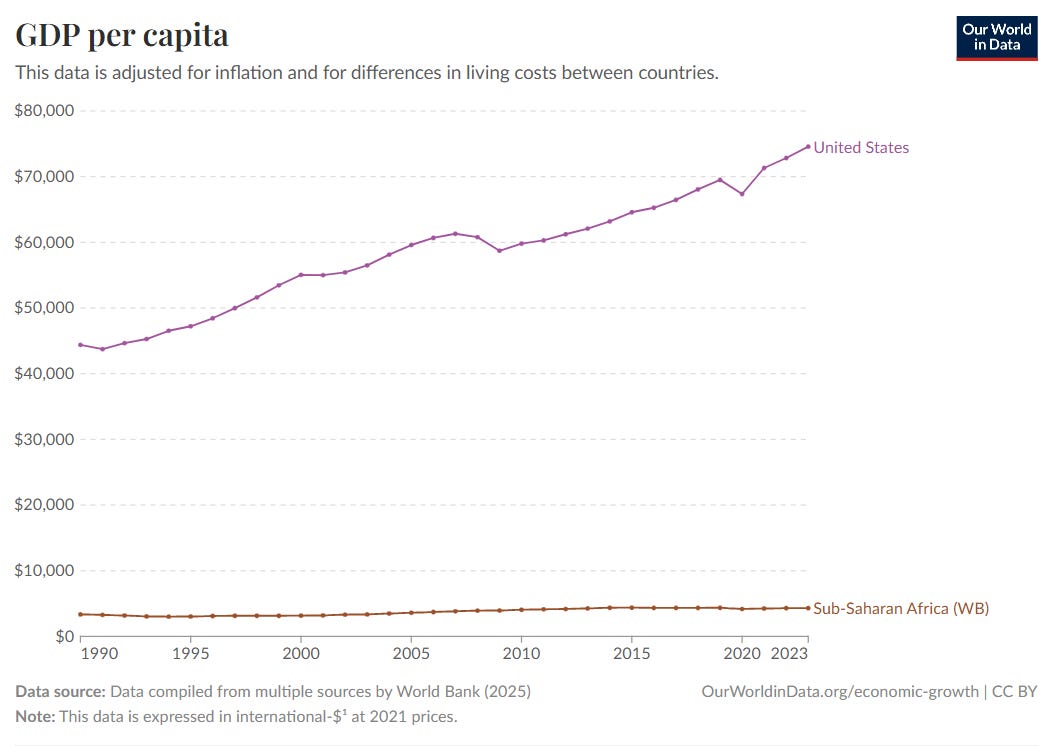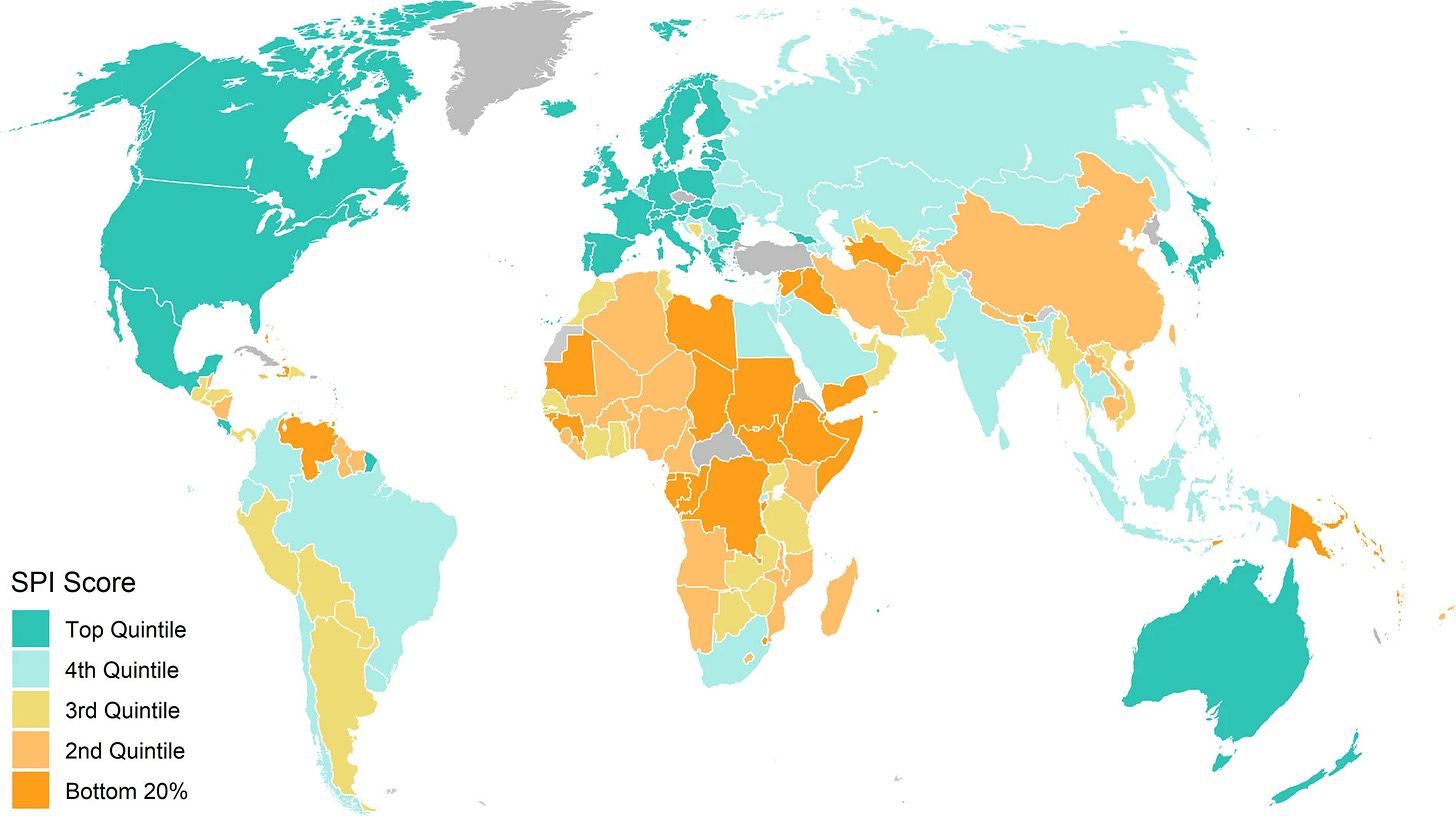Africa's Poor Numbers
How much do we really know about African state of affairs?
Introduction
It is no secret that Sub-Saharan Africa is poor. According to World Bank figures seen below, the difference between Sub-Saharan Africa and the United States is huge, even after accounting for the costs of living. On a per-capita basis, Africa is by far the poorest continent.
This piece is about a related problem, namely Africa’s poor numbers—the lack of data and low data quality that pervades Africa.
Critical commentary about Africa’s numbers is not a new thing. In the 1981 book Social and Economic Statistics for Africa, Kpedekpo and Arya wrote that African national statistical offices were simply ill-prepared to publish adequate data, “resulting in figures that are little better than random numbers.”
Roger Riddel once wrote: “perhaps the most fundamental problem with the available Africa data is that these are widely known to be inaccurate but the degree of inaccuracy cannot easily be judged—itself a sign of the underdevelopment of the region.”
More recently, Devarajan (2013), then chief economist for Africa at the World Bank, described the state of affairs as “Africa's Statistical Tragedy”. Others call it Africa’s “data gap” (Adebisi & Lucero-Prisno, 2022). But perhaps the most well-known critical appraisal of Africa’s developmental statistics is Morten Jerven’s 2013 book Poor Numbers—the inspiration of the title of this piece.
As an economist, Jerven’s interest pertained to the production of GDP figures, the sort of numbers that are illustrated in the earlier graph. What methodology and data were used to produce those numbers? How reliable were the numbers?
In 2007, Jerven visited the statistical office responsible for Zambia’s national accounts. It was only with personal experience that the gravity of the situation truly revealed itself.
There were only three employees, and just one regularly in the office while he was visiting. No employee could account for how income estimates had been generated more than a decade ago. They lacked resources and staff. They lacked basic data. Many sectors of the economy had no usable data, or estimations were made based on a very small subset of the sector’s economy. Many numbers were functionally guesstimates with no underlying rigorous and reproducible methodology.
When he revisited in 2010, the situation was even worse. As he explains (Jerven, 2013):
“What happens if I disappear?” In 2010, I returned to Zambia and found that the national accounts now were prepared by one man alone. His question was not hypothetical, but one of real concern. Until very recently he had had one colleague, but that man was removed from the National Accounts Division to work on the 2010 population census. To make matters worse, lack of personnel in the section for industrial statistics and public finances meant that the only statistician left in the National Accounts Division was responsible for these data as well.
In total, he visited eight Sub-Saharan African countries, and had extensive e-mail correspondence with statistical offices in several others.1 The problems were by no means unique to Zambia. “Similar anecdotes could be told from research visits I have made to other countries in sub-Saharan Africa since 2007,” he writes. Nor is this problem contained to economic statistics.
Africa’s poor numbers are the result of several interrelated factors: limited funding, inadequate infrastructure for data collection and management, lack of expertise and skilled workers, political instability impeding data collection, political incentives leading to misreported numbers, and corrupt politicians opposed to data transparency.
The majority of what we “know” about African state of affairs can be traced to estimates made by external organizations and actors (e.g., WHO, UN). Though the situation is slowly improving, crucial data expected from African governments are either missing or are too unreliable to be used.
In this article, I critically analyze Africa’s numbers. I begin with a summary of Africa’s general statistical capacity. Afterwards, I separately analyze three broad classes of data: economic data, crime data, and population data.
Statistical capacity in Africa
While Jerven’s Poor Numbers focuses on the gross domestic product, issues of poor data quality or missing data go well beyond economic figures. These problems are pervasive—usually especially so—in Africa. Examples include:
Lack of birth registration.
Less up-to-date censuses.
Lack of death registration, and poor cause-of-death data quality (Karlinsky, 2024; GBD 2016 Causes of Death Collaborators, 2017).
Poor civil registration and vital statistics data quality (Mikkelsen et al., 2015).
Poor homicide data quality (UNODC, 2023).
Misreported answers in surveys (e.g., Larsen et al., 2019; Seidler et al., 2025).
A nation’s ability to collect, analyze and disseminate high-quality data about its population and economy is referred to as statistical capacity. One can measure national statistical capacity by using a composite of several indicators like those just mentioned. This is what Dang et al. (2023) have done. The overall scores are illustrated below.
While poor statistical capacity is by no means exclusive to Africa, it is a near-universal problem in Africa. Of all major regions, Sub-Saharan Africa has the lowest average statistical capacity score.
The capacity of an African statistical system is strongly related to the country’s overall governance. This is according to the latest 2023 African Governance Report by the Mo Ibrahim Foundation, finding a strong correlation between the two (r = 0.78). A nation’s statistical capacity is therefore also roughly proxied by its overall ability to govern.

The same report acknowledges that the statistical capacity of Africa “remains low compared to other world regions”. In fact, only 33.5% of data sources on Sustainable Development Goals (SDGs) indicators on Africa are produced by the country’s own statistical system (p. 29). To put it bluntly, this tells us that African governments still cannot be relied upon for providing comprehensive and reliable data about the state of affairs.
While many factors contribute to Africa’s low statistical capacity, the most commonly cited contributors can be organized into four categories:
Lack of resources. Statistical capacity is expensive. A large personnel is necessary to collect, produce, analyze and disseminate high quality, comprehensive and reliable statistics. Tracking accurate statistics of births, deaths (and their causes), crimes, economic data, et cetera, for a nation’s entire population is just not a trivial task.
To take a concrete example, consider the task of conducting a census. The U.S. 2020 census alone reportedly had a price tag of approximately $15.6 billion, involving hundreds of thousands of temporary workers. Labor is cheaper in Africa, but the total costs of a census can still easily amount to the equivalent of 100’s of millions of U.S. dollars. Many African countries do not have the necessary funds, and have often relied heavily on external donations for assisting in large statistical projects such as censuses.Low human capital. Comprehensive statistical systems are reliant on many skilled workers with technical expertise. Tracking, say, health data alone requires trained doctors handling the individual cases (births, autopsies, etc), but also skilled workers to handle, analyze and disseminate the data. Furthermore, low numeracy and literacy among the general public also results in less reliable survey data.
Political conflicts and instability. Many African countries have experienced armed conflicts and general political instability in the past few decades. Examples include Boko Haram terrorism in Nigeria and civil war in Ethiopia. Collecting comprehensive and reliable data is obviously much more difficult in conflict zones.
Political incentives, corruption and aversion to transparency. It is no secret that political motivations can affect statistics. For example, there’s a political pressure to demonstrate that reforms are successful to domestic political leaders and external stakeholders. This creates a push towards reporting overly optimistic numbers in Africa (see, e.g., Desiere et al., 2016; Sandefur & Glassman, 2015; Jerven, 2014). In Nigeria, resources were allocated to states in proportion to population size, leading to fabricated and grossly inflated population counts. Lastly, political leaders may simply have an aversion to full transparency, if facts would be in conflict with the political image they want to portray.
In the rest of this article, I will consider three types of data and analyze them more in-depth separately, namely: (1) economic statistics, (2) crime statistics, and (3) population count statistics.
Economic statistics
In 2010, Ghana rebased and reviewed the basic data underlying their GDP calculation. This revision resulted in Ghana’s GDP shooting up by 62%. Newspapers reported on Ghana’s remarkable growth (Devarajan, 2013), but this wasn’t “growth”—Ghana hadn’t suddenly gotten much richer. Rather, it highlighted the unreliability of African income estimates.
African GDPs are difficult to estimate for a number of reasons. The economic data is outdated. Basic data for various economic sectors are missing. A large swathe of economic activity is unaccounted for, a problem especially pervasive in low-income countries where labor is more informal (Medina & Schneider, 2018). Newborns aren’t registered, and population censuses aren’t up-to-date (discussed more in the section on population statistics). The list of meaningful sources of error is long.
Devarajan (2013) described this as “Africa’s Statistical Tragedy,” writing: “The ‘tragedy’ is that the development community was happily publishing GDP statistics and growth figures for Ghana over the last decades, pointing out how well the country had been doing. Now we have to revise those figures. So in fact we did not know how well Ghana was doing.”
It wasn’t unique to Ghana, either. Malawi revised their GDP by +30% (Devarajan, 2013). In 2014, Nigeria’s GDP nearly doubled, being revised upward by a shocking 89%. Senegal’s grew by about 30%. Tanzania’s GDP grew by a third, Kenya’s and Zambia’s increased by a quarter, and Uganda’s rose by 13 percent (Sy, 2015).
On the one hand, the revisions told us that African countries were doing better than previously thought. On the other hand, such major revisions speak to how outdated and potentially unreliable African GDP estimates had been.
This raises an important question: how meaningfully can we really compare African GDPs? To address this question, Jerven (2010) compared African per-capita GDP estimates from the three main sources: World Bank data, Penn World Tables, and Angus Maddison estimates.2 He found a surprising amount of disagreement in country rankings between the sources.
The fundamental problem was that African GDPs were estimated from a sparse and unreliable data foundation. GDP estimates were thus highly sensitive to minor variations in assumptions and methodology.
The dearth of comprehensive and reliable economic data in Africa continues to this day. Luken et al. (2020) analyzed the industry-related data quality and conclude: “We find data quality issues least severe for two out of the five conventional economic indicators but extremely severe for the other three economic indicators.”
The organization World Economics have a data quality rating scheme designed to evaluate the usefulness of official GDP data of individual countries. African countries tend to receive the lowest scores, a fact they explicitly label as “Africa’s data quality problem.”
How reliable are national accounts data?
The central problem for African economic figures is the lack of basic data, making it impossible for national accounts to accurately track the economy. This is made even more challenging by the large “shadow economy” of informal labor present in low-income countries (Medina & Schneider, 2018).
After having visited many statistical offices of several African countries, and being in contact with even more, Jerven (2013, p. 3) points out that, in practice, African national accounts involve an unhealthy amount of guesswork, “For large shares of the economy we have little or no information and the figures involve a great deal of guesswork.”
This is verified by relevant informants. As Marivoet & Herdt (2014) mention, an informant at the World Bank office in Kinshasa acknowledged that national accounts figures of the DRC often had little basis in hard data, and were rather based on consensus of opinion:
The same informant also mentioned in passing that most national accounts of the DRC are simply subject to consensus, or, it appears, experts and consultants who sit together and decide on the size of the Congolese economy over a pint of beer. At the same time, such a consensus strategy should not come as a surprise given the large amount of pure guesswork that seems to characterise the national accounting in the DRC. (Marivoet & Herdt, 2014)
But can we measure how accurate national accounts data is? And are errors like white noise or, worse, systematic?
In a recent analysis of economic data from Mozambique in south-east Africa, Jones & Mucocana (2025) compare the official national account of agricultural output with micro-survey and other data. Their results confirm that African “official” national accounts data cannot naïvely be taken as factual.
They triangulate different sources of evidence: micro-surveys, household budget surveys, market price, and Food and Agriculture Organization (FAO) production data. These alternative data sources all roughly agree with each other, but disagree with the national accounts data.
The error appears to be substantial: “agricultural production may be one-third lower than the value stated in national accounts and long-run real growth rates in the sector have barely exceeded rural population growth.” As shown in the figure below, the alternative data sources suggest that there has hardly been any growth between 2002 and 2020.
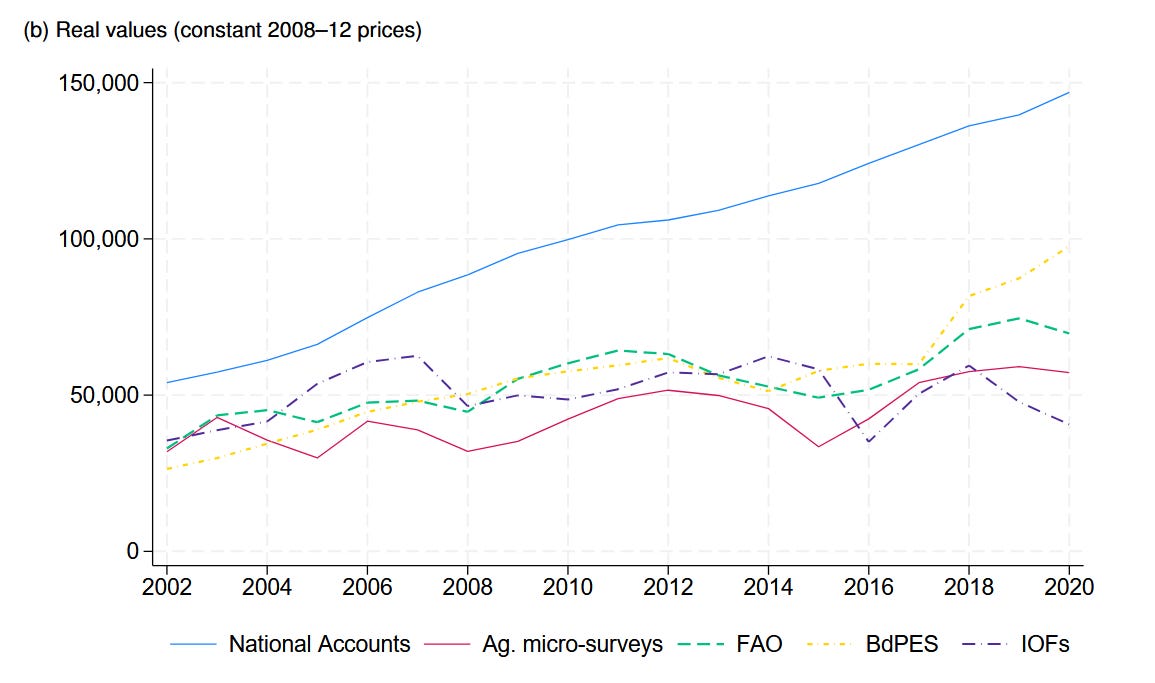
As agriculture remains a large fraction of the overall economy in developing countries, this implies that Mozambique’s GDP growth has been overstated to a practically significant extent.
The authors then expanded their analysis to other countries. They conclude that this problem may not be unique to Mozambique. Rather, the evidence suggests that “national accounts estimates of agricultural production may be more prone to being up-ward biased in lower-income economies.” A different analysis of agricultural data from six African countries also found no increase in productivity between 2008 and 2019 (Wollburg et al., 2024).
So not only has Mozambique’s agricultural productivity been overstated in national accounts data. This is possibly a general tendency in low-income countries. African economies may be performing systematically worse than official data suggests.
Mozambique is not the only African country where unreliable agricultural statistics have been uncovered.3 In Rwanda, data provided by the agriculture ministry showed a dramatic increase in yields by 60 percent following agricultural reforms. But Desiere et al. (2016) argue that these statistics are dubious, showing that are not consistent with other data (which show much less growth). Further, they argue that there’s a political incentive to inflate numbers to demonstrate the efficacy of the reforms.
There are also other examples of poor numbers in Rwanda. Many have argued that poverty figures have been manipulated in Rwanda. Briefly summarized, the accusation is that the basket of goods used to calculate the poverty line had been changed in a systematic way, effectively shifting the poverty line to make the situation look more favorable.
Though the World Bank have denied the accusations of manipulation, they have also acknowledged discrepancies between survey and national accounts estimates, writing in their Rwanda systematic country diagnosis: “The results of the three latest surveys show that per capita consumption has grown by 0.8 percent annually between 2011 and 2017, but national accounts show 4 percent growth.”
Survey data
Since official data supplied by the government is often unavailable or unreliable in low-income countries, economists have sought to measure development with alternative methods.
Household surveys have been the most widely used alternative approach. By asking people about their educational level, incomes, consumption, demographics, and so on, in principle one should be able to measure living standards without relying on government data.
In fact, household surveys have been so widely conducted to allow estimates of global variation in economic development (Smits & Permanyer, 2019). A map of sub-national income estimates is shown below:
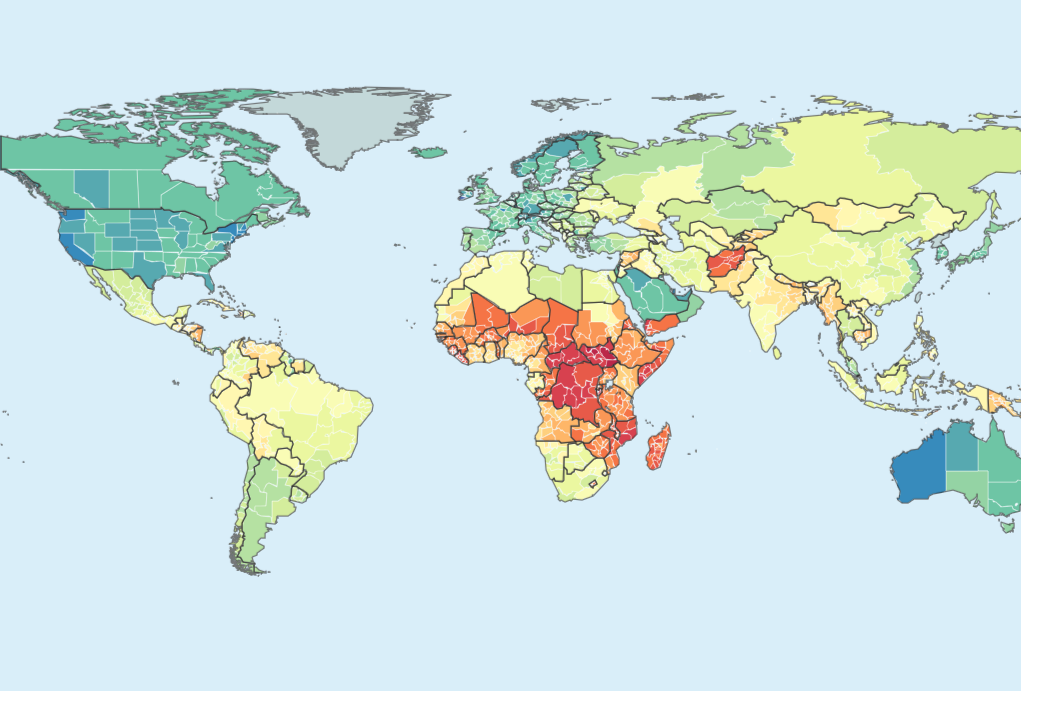
In many African countries, where state capacity is low or where the government may even be corrupt, there’s little doubt that household surveys tend to be more reliable than data provided by the government.
With that said, like any other data source, household survey data can suffer from reliability issues. In a recent assessment of household survey data quality across 35 Sub-Saharan African countries, Seidler et al. (2025) focus on three simple indicators of data quality:
Incomplete age: birth month or year missing.
Age heaping: ages ending with the digits 0 or 5. Excess age heaping is the result of rounding due to low numeracy or lack of proper documentation.
Flagged HAZ: missing or biologically implausible values for the measured heights of children.
The results show that African household survey data is often poor quality, but that unreliability is not evenly distributed across the continent. Nigeria, Niger, Ethiopia and Chad, for example, have less reliable household survey data than, say, South Africa.
Within-country local variation in data quality is also substantial. In general, data quality tends to be worse in more remote rural areas. Regional differences can be large. For example in Nigeria, the observed amount of age heaping ranged from 25% to over 60% across districts (with 20% being the expected amount if digits are approximately uniformly distributed, since 0 and 5 are two out of possible digits). In Chad, incomplete age averaged at 67.3%. But it ranged from 8.1% in Dar Tama (bordering Sudan) to 91.6% in Loug Chari in the south of Chad.
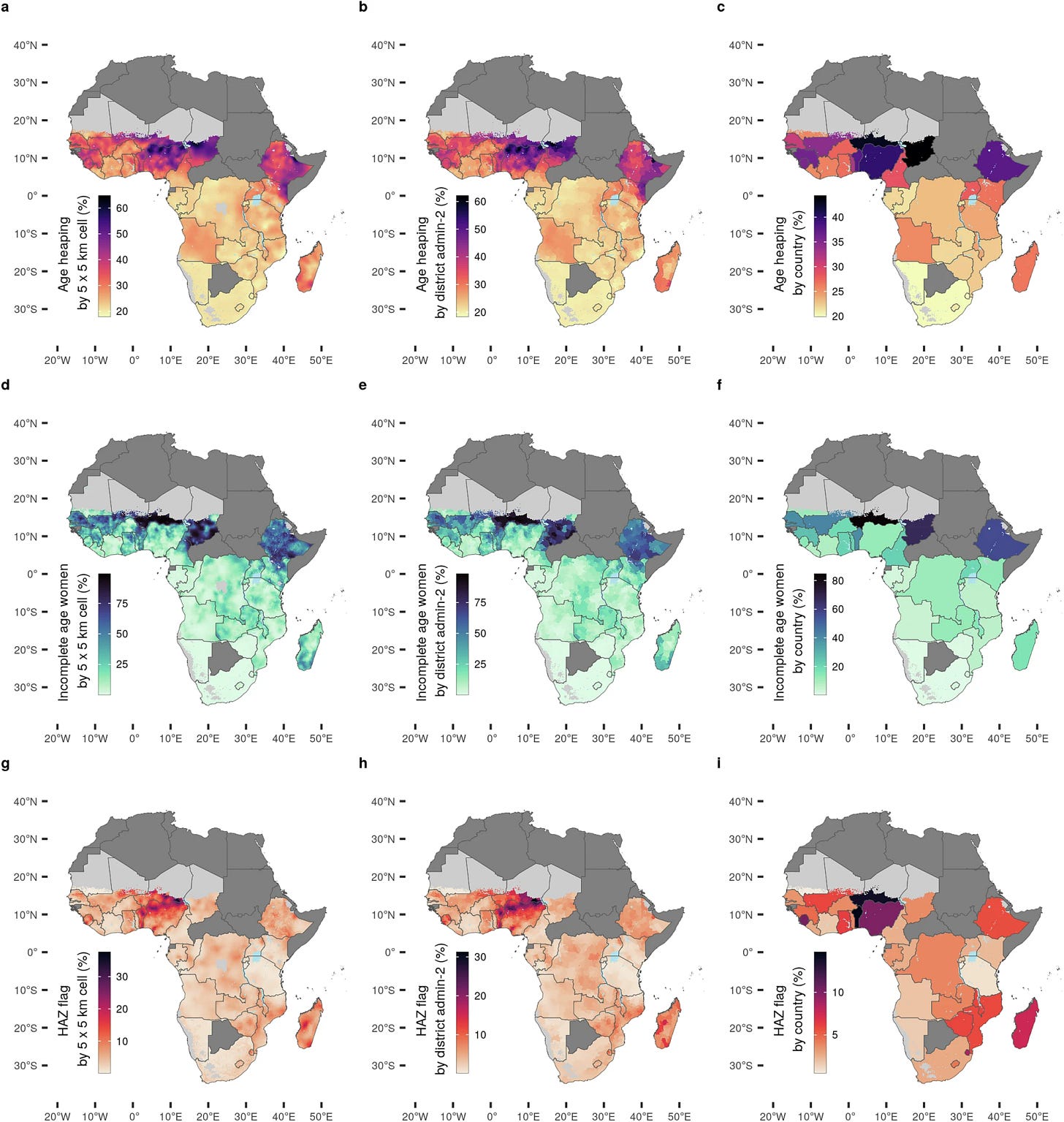
One potential issue with surveys is that people have imperfect memory. This factor has been analyzed in the context of agricultural surveys in Africa. Wollburg et al. (2021) find that systematic error increases with recall period—with longer recall periods, farmers report higher quantities of harvest, labor and fertilizer inputs.
These findings remind us that statistical capacity is not just about having well-funded statistical agencies, but also about the general public’s ability and willingness to answer questions accurately. This is partly a matter of human capital: literacy, numeracy, memory, et cetera (see, e.g., Larsen et al., 2019; Rosenzweig, 2021). Relatedly, Kinyondo & Pelizzo (2018) hypothesize that the problem is due to a “lack of research culture” among the general public.
The verdict
I’ve argued that African national accounts data should be taken with a grain of salt, to put it mildly. However, this does not mean we have no reliable information about Africa’s economic development.
I have already shown that household surveys have been widely conducted across the world, and though they have their own reliability issues, we can reasonably conclude that they paint a more realistic picture of African development than relying solely on “official” numbers supplied by the respective governments.
Even still, to satisfy skeptics of both national accounts data and household survey data, economists have sought yet other ways of estimating economic activity.
The pioneering work of Henderson, Storeygard & Weil (2012) showed that nighttime light, using satellite data, could serve as a strong proxy for economic activity. This approach has since been further worked upon to produce fine-grained development estimates (Sherman et al., 2023). Other proxies, such as mobile phone or social media data have also been used (Chi et al., 2022). Recently, Rossi-Hansberg & Zhang (2025) have combined diverse predictors and machine learning methods to produce subnational economic estimates.4
Together, all this evidence help us form a more reliable picture of African economic development, despite the low statistical capacity in the region.
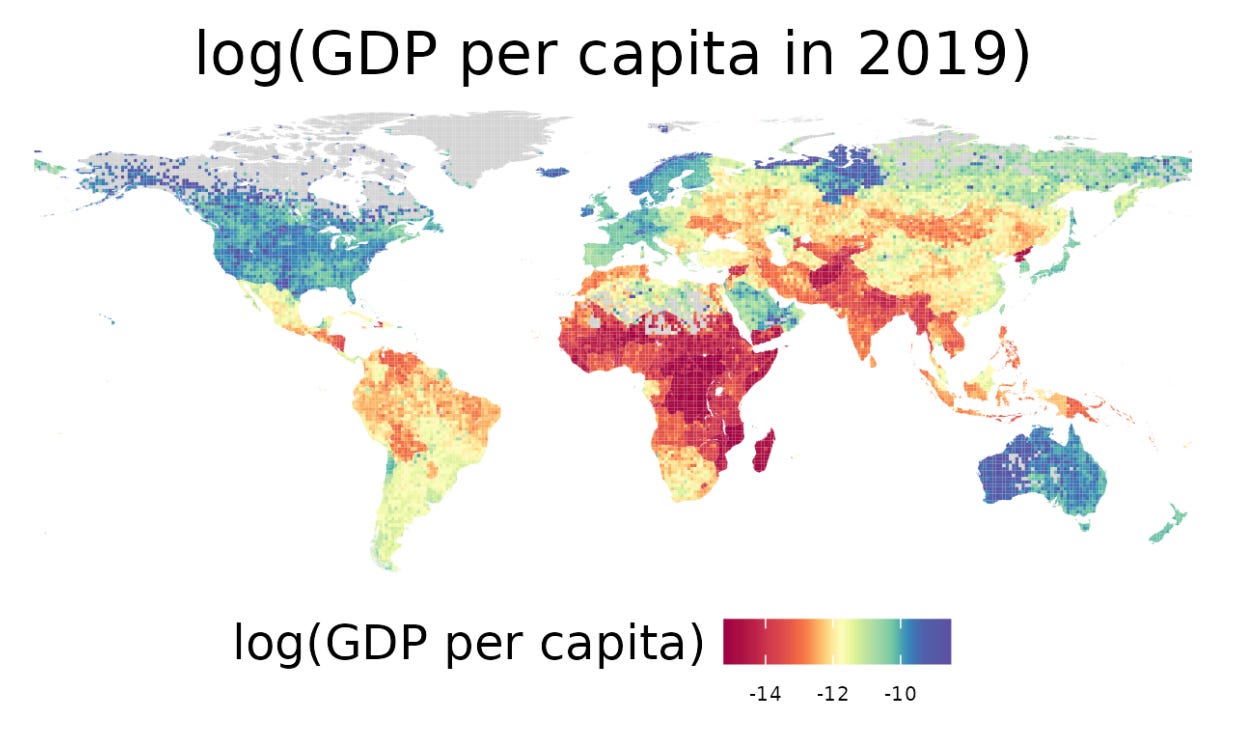
Crime statistics
Keep reading with a 7-day free trial
Subscribe to Patterns in Humanity to keep reading this post and get 7 days of free access to the full post archives.


